What are the best materials to use on a ghillie? Most people will be familiar with the traditional image of a ghillie suit, a big bulky jacket of brown and/or green string. They will be constructed of jute thread, hessian or strips of burlap, natural fibre materials that work very well at real sniper ranges of up to a couple of miles, but less effective when viewed up close such as the short distances airsoft is played at due to restrictions on our weapons. It’s not a bad thing though, because it forces us to really push ourselves to develop far more effective camo.
When choosing what to add onto your suit, first go back to your site pictures as mentioned earlier and take a really good look at what grows there. If you attach things to your suit that aren’t present in the environment you’re working in, it’ll stand out and look odd, such as ivy leaves in a grassland terrain.
Most materials are easily sourced from ebay, amazon.com or aliexpress and I’ll attach links in each section. Locally, I have a florist wholesalers which is full of artificial plants for flower displays and arts and crafts shops are always worth a visit. Don’t be afraid to shop at places your grandma does. I’ve used Amazon for most bits so that it’s easier to fill your basket in one place, and you can grab 30 days of Amazon Prime for free to get all your shit delivered.
1. Raffia

I have to start with raffia. I’ve always told players that it’s God’s gift to snipers. Raffia is made from dried palm leaves, which can be pulled into strips to give something that looks like dried grass. Main use? Replicating grass. Grass is everywhere, in large amounts in fields but also small clumps in woodland areas. Raffia is very cheap, and very easy to colour too. It looks far more realistic than jute string, and behaves a lot more naturally in the wind and in shape. Strands of raffia stick out from the suit giving a great effect of depth and help break up body shapes, which is very important.
Colour wise however, never be tempted to add natural coloured raffia straight onto the suit. Although it looks like dead grass, out in the environment it turns out to be a really bright white colour and is very visible to other players. Try soaking it in tea and coffee, ink or dye first to darken and dirty it up. It’s very easy to turn green too, but also worth considering in dark browns to replicate sticks and twigs in all environments, especially woodland suits. Layer the darker colours underneath and then lighter shades on top, making sure to avoid putting a lot of the same shade in one place.
Raffia is amazingly versatile, doesn’t catch on vegetation and should definitely be the first material on your list regardless of where you play.
Links to raffia :
Natural raffia (everything from dead grass to twigs and crap – this is a very big bundle)
2. Leaves

There’s a bit of a flaw with leaf suits. Yes, they have that 3D leaf pattern already sewn on, but if you look closely, all those leaves are the same size, shape, colour/pattern and on most of the budget suits, they’re arranged in straight lines. If you thought the leaf suit was an easy shortcut, it isn’t. Thankfully, leaves are easy to make and add on. There are plenty available online, but one of the best buys are packs of silk leaves, often referred to as Chinese leaves due to their origin (assuming they are cheaply made in Chinese factories; I certainly have most shipped from there). See the Leaf Crafting Guide for how to make them into something far more realistic and usable. Available in bulky numbers, the silk leaves are another easy material to work with, but are all maple leaf shaped and that might not be suitable for everyone, so it’s worth shopping around for alternatives to mix in too. Try to avoid any red coloured leaves; these won’t take colour very well and are generally a waste of time. Yellow leaves are ideal for turning into brown ones (most leaves on the floor are dead anyway, they won’t retain colour), and green ones are useful during summer months. Just make sure, as outlined in the leaf crafting guide, that you take time to distort them into different shapes. There is nothing worse than a suit where someone has stuck flat, uniform leaves all over it. It’s not natural, and unnatural is bad.
Leaf links :
Silk leaves (absolute crafting basic, very cheap, very effective)
3. Other artifical plants

The easy bit. Buy fake artifical plants and zip tie onto the suit for instant camouflage. Right? Wrong.
Again, this comes down to how closely you’ve looked at your environment (snipers have a lot of homework to do). Yes, it is very easy to buy lots of different artificial plants but the wrong type in the wrong place will give you away. Ivy is a very common one I see on a lot of suits but at a few sites local to me, there’s no ivy at all and the dark green leaf really stands out. Similarly ferns, also easily available online but not always found at sites.
No airsoft player in the middle of a game is going to notice that your artificial plant is the right species but wrong subspecies for your area, so don’t worry about going into too much detail (not every plant will be available as a plastic model), but try and match leaf size and shape if nothing else. Be wary of very cheap plants that are too plastic looking, and most will require a very light dusting using brown spray paint to take the shine off a little.
The biggest advantage to using artificial plants on your suit is that they won’t die off like natural veg does during a game, and can be better and more carefully positioned in advance. Almost all will be attached to some kind of stalk which really helps with creating depth on your suit. Some of them come attached to vines, and are very easy to cut and attach as needed. The plastic stalks on the vines will help add 3D depth to the suit as well, and are a quick and easy way of adding greenery during summer months.
Links for useful plant bits :
Leafy vine (very generic, good in a lot of environments)
Fern Leaves (for adding greenery)
4. Cotton

Often shunned now by players who prefer lighter weight polyester materials on their builds that don’t soak up water, cotton is really useful because…it soaks up water. Natural materials are also more IR resistant if you’re up against operators with night vision devices.
A couple of videos by Le Covert (please check out his page) demonstrate that soaking up water does have a really useful purpose – it darkens when wet. Which is exactly what nature does after rain. Think of the soil, and dead leaves on the floor. Cotton will require cutting to shape, but is easily zip tied on during the earlier stages of constructing your suit. In terms of weight, remember that other players are running around with full metal assault rifles, often carrying heavy rigs loaded with magazines and ammo, so to be fair us snipers do get off quite easily. It’s not like you’re having to carry bricks or anything. Cotton bias binding is very lightweight and easily shaped.
Links for cotton fabrics :
Bias binding (lightweight, thin, cut into rough strips and soak in water to mimic dead leaf matter)
5. Burlap

Burlap is quite an old school ghillie material but still very effective. Made from fibres of jute plants, burlap is usually woven into a cloth and for snipers, cut into strips and dyed before being added to suits. It has a tendency to fray once cut, is easily pulled apart and gets a messy effect quite quickly with use. Jute thread, available from gardening centres, is the same stuff but in string form, and it’s fibres fray or can be pulled apart. This is the stuff you usually see in traditional sniper suits and some military retailers will sell bundles of coloured jute threads as sniper camo, but on its own just leaves you looking like a big pile of string. When mixed in with other materials however it is really useful for bulking up and adding other textures. Being heavier than raffia, it hangs downwards rather than floating in the wind. Still a very good material to have handy, and again natural materials are useful to us.
Links for burlap stuff :
Burlap sheet (either use on its own or pull individual threads off to mimic grass)
Burlap strips (for lazy people, pre cut, just needs dyed)
Jute string (for even lazier people in grassy environments, layer under raffia for more depth)
Coconut rope (for replicating twigs etc, much thicker than jute string)
6. Leaf strips/3D camouflage elements

Jack Pyke, if you can find their products, did make strips of leaves in the same style as their 3D leaf suits, but in a 30cm or so strip that could be attached to suit or kit. Since then, a few Russian and Chinese manufacturers have produced similar leaf strips. They are great for adding to rifles, but also if you have webbing or a backpack, very useful to allow you continue the pattern of your suit onto other kit so that it doesn’t look too different to the rest of you.
There is another option, from Nitehawk, who make shooting blinds out of the same material as their leaf suits. These sheets of material will usually only cost around £30 but provide enough material to kit out your webbing, backpack, rifle, boots, headpiece and gloves. I have even known one guy make his suit out of a sheet of it from scratch using a template, which allowed him tailor his suit to himself. It’s the same lightweight mesh and even little offcuts afterwards can be used for adding extra depth to everything, extra leaves to your leaf suit and whatever else you need.
Links for leafy stuff :
3D leaf net (ideal to cut up and spray, larger leaves)
7. Camo Netting
A personal favourite. Camo netting is generally cheap and easy to get hold of, and while on its own doesn’t look like anything spectacular, it’s very easy to spray different colours, is easily cut into different shapes and can be attached anywhere. Although a uniform pattern, it does add 3D depth quickly and easily and you can use zip ties to “pull” it in different directions to stretch the netting into slightly different shapes.
Here’s a pic of some camo netting side by side with a very good leaf suit. The netting has had a bit of paint added, and the 3D effect is noticeable.
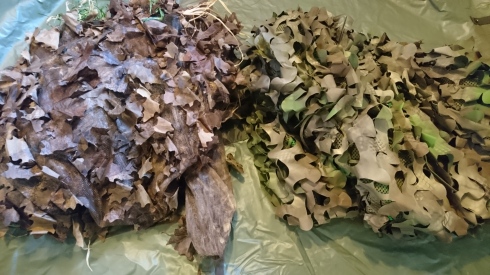
Camo netting is available in a few different patterns, or plain colours. Some genuine surplus stuff is attached to netting, which is useful too for mounting camo onto, but I’ve used the cheap commercial stuff and just glued directly on, or zip tied through the holes in the netting which works just as well. Avoid the zigzag pattern camo netting though, sometimes too cheap is just too cheap.
Links for good camo netting:
8. Scrim
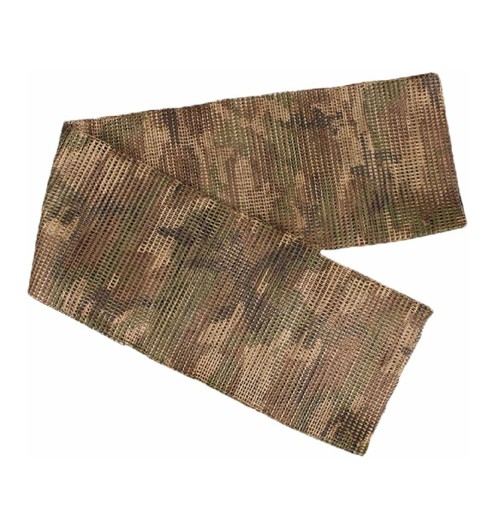
Most players will pick up a scrim scarf at some point, basically a mesh rectangle, but useful too for building onto. Scrim is very strong netting, and although the holes are small, you can easily use micro zip ties to attach materials on. Scrim is great therefore for making camouflage “panels” which you can use as rifle wraps, head covers or just as a way to switch camo (consider a winter suit, an adding a scrim panel decorated with summer vegetation that can be fixed on when you need it… ).
Links for scrim :
Cheaper scrim (available in different colour options)
IR resistant scrim helmet cover (different, but effective)
9. Spray Paints

Yes, it’s a crucial material. A good selection of spray paints is essential for adjusting colours to match different environments and different seasons. It’s always worth taking some to the site with you so you can make adjustments once you get there. Krylon is a military grade weapons paint and probably the best known, although expensive, but any matt effect paint will be fine. Obviously those bought from military and airsoft websites will be ideal and available in more suitable colours. Browns and tan are good starting points, adding greens can be a little tricky because you need to carefully match your greens up, but colours like olive greens and grass greens are always a good match. I’ve listed Krylon woodland green here because it’s hard to find on military sites but a very good colour.
Links for good colours, aim for tan/dark brown and a green as a minimum:
Pale Green (lighter grass shades)
Grey Brown (this stuff is excellent)
10. Inks and Dyes

Depending on what you want to colour, there are two types of dyes. Fabric dyes, easily available, will work on natural materials like cotton no problem at all. Some you just mix in a bucket and add clothing in (better method – sometimes comes out blotchy and uneven which is great for camo), others go in the washing machine with the clothing.
However,
If you want to dye a leaf suit or a ghillie cape, or even modern polyester BDU’s, you’ll need a polyester dye like Idye Poly.
Remember that dye doesn’t come off. Which means your suit won’t mess up in the rain, but you won’t be able to put your suit back to its original colour either. Often, a lot of the North American leaf suits are found to be a little light in colour or even too grey for European woodlands, so a lot of players will dye them a dark brown to adjust the colour. Be careful when dyeing to get the right colour that you need, although if you do mess it up you can always go over with spray paint in patches. And that’s my major criticism of dye – it’s a flat, all over colour so it will show you up as a human outline without variation. As above though, spray paint in patches can help to resolve that.
Personally, I don’t use a lot of dye, and prefer inks. I use acrylic inks, available from an arts and crafts shop down the road. These are what I use for the silk leaves, raffia, cotton and even put some in a spray bottle to darken my dpm webbing. It works fantastically well, although expensive for little bottles. I add some mixed with water (about 2 ink to 1 water depending on how strong I need the colour) into sealable food bags and then shake it up to coat whatever I’m colouring. It’s waterproof too, ideal for outdoors kit.
Links for the Inks ;
Magic colour (lots of colours)
11. Artificial Moss
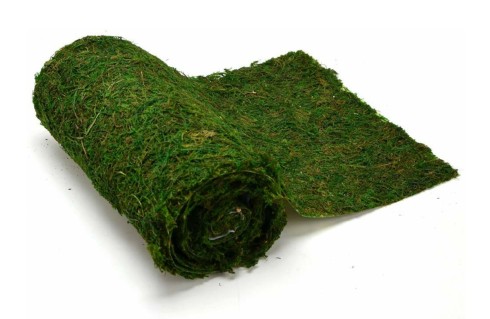
Widely available, “artificial” moss is actually just real moss, dried. It’s quite brittle stuff but can be glued into place, although it will flake off after time. An alternative is flock, used by modelers on trains and miniatures. It’s basically green sand, but will stick and add a slight mossy coated effect.
Links for mosses:
Moss sheets (easier to use than balls of moss)
12. Camo Tape

Down the years, I’ve done loads of spray jobs in rifles but no matter how good the design, and how matt the paint, because it went onto plastic and metal it always had a smooth sheen on it. So recently, I’ve been switching to tapes instead. Instant pattern, but also the advantage of being able to glue stuff on without ruining the gun – just peel the tape off to start a new camo job.
There are three main types of camo tape available.
Firstly, the self cling camo tape. Usually looks like mesh, this stuff is shit and doesn’t stick to anything, let alone itself. Don’t buy it.
Secondly, Gorilla tape among others have made realtree camo type tapes which are fairly easy to get hold of and stick well. They’re waterproof, but in doing so have the same sheen as spray paint. A light dusting of spray paint (yeah I know) can help a little.
Fabric tape is the way forward. Jack Pyke have some called “tough tape”, which can be hard to track down but is absolutely fantastic stuff. Because it’s fabric, it doesn’t have a smooth surface to reflect light. The pattern(s) are good, and it helps quieten your rifle by absorbing a few of the vibrations off the metal before they hit the air. There are a few other fabric tapes on the market too, and for urban games I use the British Army Scapa tape as a base, although bear in mind fabric tape doesn’t take spray paint as well so for any detail work, use fabric paints or similar. Scapa tape is extremely good quality though and you get loads of it. Flecktarn tape is a great forest floor camo too, I’ve used it in the past and actually miss having a flecktarn VSR.
Links for decent tapes :
13. Meshes

Mesh is useful for adding depth to a suit. There is a highly specialised mesh available for Ghillie suits called Haloscreen, which is IR resistant to boot, but expensive. Check out Theyma HP on Facebook. As alternatives, insect mesh and tulle are useful for blurring edges while still showing a little of the environment too through the mesh. Unfortunately, although many people do try to use tulle, it’s a lot more delicate and falls apart easy on the suit. Insect mesh is tougher and will give a better shape. Here’s a couple to consider :
14. Artificial Grass

Like artifical moss, artifical grass is excellent in patches on your kit to replicate grass. Artificial grass sheets can easily be cut up and attached to scopes, barrels etc to introduce more colours and textures. Be careful not to get the really really cheep stuff though, it’s awful. I’ve found a link for a very good 10cmX10cm sample, which you could order several of.
Link for artificial grass sheets :
15. Other essentials
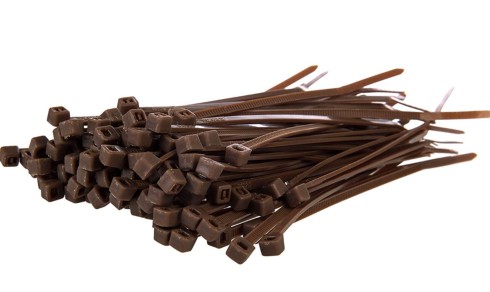
Other stuff that you need to build your ghillie with. Firstly, attaching things is done best using zip ties, that way you can take it back off again of you need to change camo for different seasons. Brown mini zip ties are the answer, you don’t want big ties and you don’t want them to show up on your suit either. Always keep a bag of them on you as well to add stuff in the field, or repair your current camo.
Additionally, adding real veg can help depending on the environment, and it’s always worth taking a pair of cutters with you to gather material. They’re also damn useful when you find a great position to shoot from but find plants obscuring either your view, or the shot. Top tip.
Links for other useful bits:
Zip ties (for everything, basically)
Pocket snips (compact, essential bit of kit)
That should cover the basics and you’d get a lot of good camo just using the stuff listed above, but always be on the lookout for new materials. Remember to assess your environment first. If it’s not in your environment, it doesn’t go on your suit!
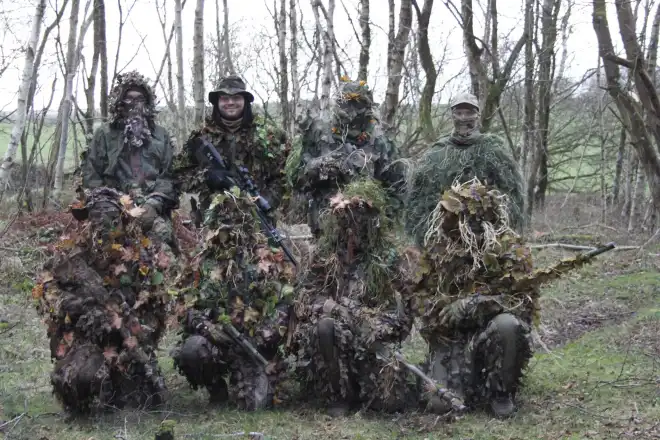
Great reading Stip!
Alot of work puted to this, appreciated the effort!
Thanks.
LikeLike
wonderful information source , well thought out, piece giving tips that saving expense for the average airsoft player, very informative . will any these hints on gameplay and concealment be made for the publication and possibly you tube ?
LikeLike
what length of zip ties do you recommend most? 6″ or 4″?
LikeLike
Hi, given that you’re going to pull them tight anyway, either length will do because you’ll cut the excess off. Depends on what’s available to you
LikeLike
Great info! Will be embarking on my on crafting soon. Thanks
LikeLike
great info really helped me make my own ghillie suit!
LikeLike